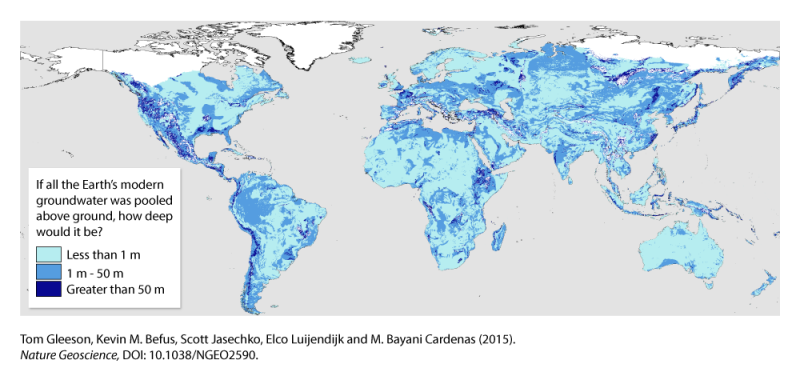File:Groundwaterstudy 1.png
Groundwaterstudy_1.png (800 × 384 pixels, file size: 237 KB, MIME type: image/png)
"Since we now know how much groundwater is being depleted and how much there is, we will be able to estimate how long until we run out..."
Groundwater: it's one of the planet's most exploited, most precious natural resources. It ranges in age from months to millions of years old. Around the world, there's increasing demand to know how much we have and how long before it's tapped out.
For the first time since a back-of-the-envelope calculation of the global volume of groundwater was attempted in the 1970s, an international group of hydrologists has produced the first data-driven estimate of the Earth's total supply of groundwater.
The bigger part of the study is the "modern" groundwater story. The report shows that less than six per cent of groundwater in the upper two kilometres of the Earth's landmass is renewable within a human lifetime.
"This has never been known before," says Gleeson. "We already know that water levels in lots of aquifers are dropping. We're using our groundwater resources too fast—faster than they're being renewed."
With the growing global demand for water—especially in light of climate change—this study provides important information to water managers and policy developers as well as scientists from fields such as hydrology, atmospheric science, geochemistry and oceanography to better manage groundwater resources in a sustainable way
Read More -- http://phys.org/news/2015-11-earth-hidden-groundwater.html / Nov 2015
○ ○ ○ ○ ○ ○ ○ ○ ○ ○ ○ ○ ○ ○ ○ ○ ○ ○
Nature Geoscience | Original Research Study
The global volume and distribution of modern groundwater
Tom Gleeson, Kevin M. Befus, Scott Jasechko, Elco Luijendijk & M. Bayani Cardenas
Groundwater is important for energy and food security, human health and ecosystems. The time since groundwater was recharged—or groundwater age—can be important for diverse geologic processes, such as chemical weathering, ocean eutrophication and climate change. However, measured groundwater ages range from months to millions of years. The global volume and distribution of groundwater less than 50 years old—modern groundwater that is the most recently recharged and also the most vulnerable to global change—are unknown. Here we combine geochemical, geologic, hydrologic and geospatial data sets with numerical simulations of groundwater and analyse tritium ages to show that less than 6% of the groundwater in the uppermost portion of Earth’s landmass is modern. We find that the total groundwater volume in the upper 2 km of continental crust is approximately 22.6 million km3, of which 0.1–5.0 million km3 is less than 50 years old. Although modern groundwater represents a small percentage of the total groundwater on Earth, the volume of modern groundwater is equivalent to a body of water with a depth of about 3 m spread over the continents. resource dwarfs all other components of the active hydrologic cycle.
File history
Click on a date/time to view the file as it appeared at that time.
| Date/Time | Thumbnail | Dimensions | User | Comment | |
|---|---|---|---|---|---|
| current | 18:44, 18 November 2015 |  | 800 × 384 (237 KB) | Siterunner (talk | contribs) | http://www.nature.com/ngeo/journal/vaop/ncurrent/full/ngeo2590.html http://www.nature.com/ngeo/journal/vaop/ncurrent/extref/ngeo2590-s1.pdf http://phys.org/news/2015-11-earth-hidden-groundwater.html Category:Aquifers Category:Green Graphics ... |
You cannot overwrite this file.
File usage
The following 2 pages use this file:
